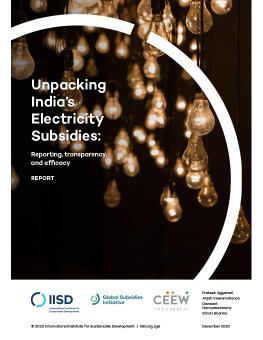
Unpacking India’s Electricity Subsidies: Reporting, transparency, and efficacy
This report brings together data on the state of electricity subsidies in India, covering all states and union territories, based on Power Finance Corporation reports and state-level documentation. It analyzes changes from FY 2016 to FY 2019—before and after the implementation of the Ujjwal DISCOM Assurance Yojana (UDAY) scheme, a central government bailout that required electricity distribution companies to improve performance in many areas pertaining to their finances.
-
Direct tariff electricity subsidies from state governments in India have increased 32% since FY 2016, amounting to INR 110,391 crore (USD 14.96 billion) in FY 2019 (4.52% of the total budget outlay for FY 2019; 37.36% of the budget allocated for defence expenditure in FY 2019).
-
Electricity distribution companies in 24 out of 31 Indian states showed a revenue gap in FY 2019, while none of the Indian states providing subsidies have adhered to the rules on subsidized tariff limits under the National Tariff Policy.
-
Annually since FY 2016, at least seven Indian state governments have delayed subsidy disbursements to electricity distribution companies, adding to the financial predicament of these companies.
Subsidies for electricity consumption are the largest of all of India’s quantified support for energy: direct tariff subsidies from state and union territory (UT) governments amounted to INR 110,391 crore (USD 15.6 billion) in fiscal year (FY) 2019. The report authors estimate that cross-subsidies added at least another INR 75,027 crore (USD 10.2 billion). Rising electricity subsidies are indicative of poor performance by electricity distribution companies (DISCOMs) with regard to the Ujjwal DISCOM Assurance Yojana (UDAY) scheme, a central government bailout that required them to improve financial performance by 2019.
DISCOM finance trends show indicators moving in the wrong direction:
- Sales revenue as a share of total expenditure has fallen 3% from FY 2016 to FY 2019, despite the fact that UDAY required DISCOMs to increase revenue recovery. In FY 2019, 24 of 31 states and UTs had a revenue gap.
- 19 of 31 states and UTs have a higher cost of supply than in FY 2016. Jammu & Kashmir and Sikkim are the jurisdictions where FY 2019 costs are significantly lower.
- Most states and UTs have not reduced billing losses in line with targets. Under UDAY, states had to reduce “aggregate technical and commercial (AT&C) losses” to 15% by FY 2019. Poor collection is typically the biggest contributor to these losses. In FY 2019, only 6 of 31 states and UTs had met this target.
In different states, subsidy outcomes are moving in different directions, but there are common challenges with tariff design and cross-subsidies across states:
- A PFC report shows that 24 states and UTs provided direct tariff subsidies in FY 2019. In 12, there has been an increase in subsidies as a share of total expenses since FY 2016; in seven, there was a decrease; and in five, the subsidy share remained constant. Among the jurisdictions with decreasing dependence, only one (Himachal Pradesh) had no revenue gap, indicating true progress.
- Nationally, agricultural consumers were allotted 75% of total subsidies, followed by domestic consumers at 20% and industries at 4%. Only four states (Delhi, Haryana, Tamil Nadu, and Uttar Pradesh) have specified subsidy support for a fixed number of units. In every year from FY 2016 to FY 2019, at least seven states and UTs had not transferred the full subsidy amounts to DISCOMs by the end of the financial year.
- No state or UT billed consumers within the National Tariff Policy target range of +/-20% of the average cost of supply (ACoS). In 12 of 31, both industrial and commercial users were charged over 120% of ACoS, and both domestic and agricultural users were charged less than 80%.
Recommendations in the report to improve policy-making on subsidy allocation and targeting can be implemented only if transparency and data reporting are considerably improved:
- Only 13 states and UTs with subsidies clearly report subsidy data, with only seven reporting on subsidies by category. Further, data on 15 states and UTs show significant variation depending on the source of reporting (PFC or state documentation such as tariff orders.
Additional downloads
You might also be interested in
Part 1 – How Can India’s Energy Sector Recover Sustainably from COVID-19?
From IISD and CEEW, Part 1 of a three-part commentary series takes a deep dive into how India’s energy sector is coping with the impacts of COVID-19 and what this means for the sustainable energy transition.
How to Target Electricity and LPG Subsidies in India: Step 1. Identifying Policy Options
This report identifies knowledge gaps that are limiting policy making for better targeting of energy access subsidies in India. It identifies a number of targeting interventions that could be employed to better target subsidies for electricity and LPG.
COP27 diary (November 16): '$100 billion in climate finance more of gesture from rich countries'
The 27th Conference of Parties (COP27) to the United Nations Framework Convention on Climate Change in Sharm El-Sheikh, Egypt, began November 7, 2022. Here’s a look at what happened on day 10 of COP27 climate talks. The draft text for a cover decision is yet to be produced by the COP27 Presidency as of 7.30 am November 17, leading many to wonder how long discussions will continue to arrive at a consensus on the document once released. Just two days of the summit remain.
Governments are subsidizing the destruction of nature even as they promise to protect it
When dignitaries from 196 countries converge in Montreal next week to rub shoulders and hash out a new global agreement to save nature, money will be on the agenda.